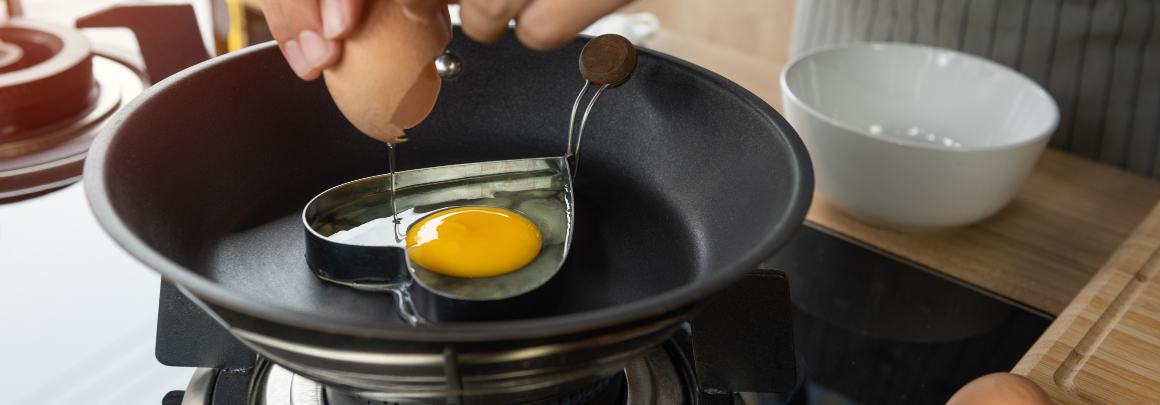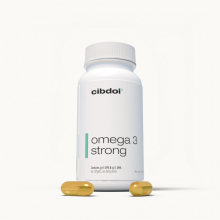Does Cooking Eggs Destroy Their Omega-3 Fatty Acids?
Published:
Eggs are a nutritious food that provide protein, vitamins, minerals and other beneficial nutrients like choline. Some eggs also contain higher levels of omega-3 fatty acids. This leads to the question - does cooking eggs reduce their omega-3 content?
Contents:
- Omega-3s in Eggs
- Why Omega-3s Matter
- Cooking Methods Retain Omega-3s in Eggs
- High Heat May Lower Omega-3s Over Time
- How Much Omega-3 Do You Need?
- How Many Eggs for 500 mg Omega-3?
- Top 10 Food Sources of Omega-3s
- Healthy Ways to Eat Eggs
- Key Takeaways
-
Frequently Asked Questions
- Q: Do omega-3 eggs need to be refrigerated?
- Q: Does frying damage omega-3s more than boiling?
- Q: Do you lose omega-3s in cooked egg whites versus yolks?
- Q: Should pregnant women avoid undercooked eggs?
- Q: Can cooking make eggs more nutritious?
- Q: Do omega-3 eggs taste fishy?
- Q: Are brown or white eggs more nutritious?
- The Bottom Line
The good news is that cooking eggs using most standard methods does not destroy or deplete their omega-3s. The omega-3s remain stable throughout frying, boiling, scrambling, baking and most other cooking techniques.
However, very high heat for prolonged periods, such as when grilling or broiling, may lower omega-3s over time. Overall though, cooking your eggs as you normally would retains their nutritional value.
Below is a detailed look at how different cooking methods affect the omega-3s in eggs.

Omega-3s in Eggs
Chicken eggs naturally contain small amounts of omega-3s, typically between 30–60 mg per egg yolk (1).
However, eggs from hens fed an omega-3 enriched diet contain much higher levels. These “omega-3 eggs” can provide 150–300 mg of omega-3s per yolk (2).
The omega-3s in eggs are mostly in the form of ALA (alpha-linolenic acid). ALA is a plant-based omega-3 found in foods like walnuts, flaxseeds and soybeans.
Eggs don’t normally contain significant levels of the omega-3s EPA and DHA, which are found in fatty fish. Though omega-3-enriched eggs may contain added EPA and DHA.
No matter what kind of eggs you buy, cooking them using standard methods retains most of their omega-3 fatty acids.
Why Omega-3s Matter
Before discussing how cooking affects omega-3s in eggs, let’s look at why omega-3s are so important for health.
Heart Health
Omega-3 fatty acids provide major benefits for heart health and function:
- Lower triglycerides - High triglycerides increase heart disease risk. Omega-3s can lower them by up to 30% (3).
- Reduce blood pressure – Omega-3s act as mild blood thinners to reduce blood pressure (4).
- Prevent plaque buildup – Omega-3s reduce fatty plaque inside artery walls (5).
- Reduce irregular heartbeats – Omega-3s help normalize heart rhythms (6).
- Improve cholesterol - Omega-3s raise good HDL and lower bad LDL and triglycerides (7).
Brain Health
Omega-3 fatty acids play important roles in brain health and development:
- Enhance memory and thinking – Omega-3s are linked to better memory and cognition (8, 9).
- Alleviate depression – Higher omega-3 levels are tied to lower rates of depression (10).
- Support fetal brain development – Omega-3s are vital for brain growth in infants (11).
- Benefit aging brains – Omega-3s help prevent decline as we age (12).
Eye Health
Your retinas have very high omega-3 concentrations. Omega-3s support vision by:
- Reducing macular degeneration – A leading cause of blindness (13).
- Treating dry eye disease – Improving tear production and quality (14).
- Benefitting children’s vision – Higher omega-3 intake in pregnancy reduces babies’ vision problems (15).
Anti-Inflammatory Effects
Omega-3s have powerful anti-inflammatory properties. They can:
- Lower inflammation – Omega-3s reduce inflammatory markers like C-reactive protein (16).
- Relieve joint pain – Omega-3s reduce swelling and stiffness in rheumatoid arthritis (17).
- Help autoimmune issues – Omega-3s may benefit lupus, eczema, IBD and psoriasis (18).
Clearly, getting enough omega-3 fatty acids is crucial for good health. Fortunately, cooking eggs preserves their omega-3 content.
Cooking Methods Retain Omega-3s in Eggs
Research shows omega-3s remain stable in eggs when cooked using standard methods, including:
Boiling
Boiling eggs has no effect on their omega-3 content, whether soft, medium or hard boiled (19).
Poaching
Poached eggs retain 100% of their original omega-3 content (19).
Baking
Baking eggs into dishes like quiches, casseroles or breads causes no omega-3 loss (19).
Frying
Pan-frying eggs over medium heat does not degrade their omega-3 fats (19).
Scrambling
Gently scrambling eggs on the stove has no impact on omega-3 levels (19).
Microwaving
Quick microwaving does not destroy omega-3s in eggs (19).
The protein and fat components of eggs help protect omega-3s from damage during heating.
As long as eggs aren’t overcooked at very high temperatures for prolonged periods, their omega-3 content remains stable.
High Heat May Lower Omega-3s Over Time
While standard cooking has little effect, very high temperatures may lower omega-3s in eggs with extended cooking times.
Methods like grilling, broiling or sautéing over very high heat for more than 10 minutes can slightly deplete omega-3s over time, by up to 20% (19).
Still, a 20% loss is relatively small. And it only occurs with extreme, prolonged heat.
Overall, research clearly demonstrates that cooking eggs maintains their omega-3 content in the vast majority of scenarios.
How Much Omega-3 Do You Need?
Now that you know cooking eggs retains their omega-3s, how much omega-3 do you need each day?
Major health organizations recommend (20, 21):
- 250–500 mg of combined DHA and EPA per day for healthy adults.
- 300–900 mg of DHA per day for pregnant/breastfeeding women.
- At least 250–500 mg per day for children based on age.
Vegans may need more due to low intakes from plant-based diets. Those with heart disease or high triglycerides may benefit from 1,000–2,000 mg daily (22).
Ideally, get a combination of both plant (ALA) and marine (EPA/DHA) omega-3 fats.
While eggs contain omega-3s, the amount can vary substantially based on the chicken’s diet.
How Many Eggs for 500 mg Omega-3?
The number of eggs needed to provide 500 mg omega-3 depends on the amount in each egg:
- Conventional eggs contain 30–60 mg omega-3s per yolk (1). You would need to eat 9–16 conventional eggs daily to get 500 mg.
- Omega-3 enriched eggs provide 150–300 mg omega-3s per yolk (2). Just 2–3 omega-3 eggs fulfills the 500 mg recommended minimum.
- Pasture-raised eggs may have slightly higher levels than conventional, but less than enriched eggs. About 5 pasture-raised eggs would provide 500 mg.
While eggs do contain omega-3s, you would need to eat a large amount of conventional eggs to meet targets. Omega-3 enriched eggs are a more practical option.
Top 10 Food Sources of Omega-3s
Beyond eggs, here are the top 10 dietary sources of anti-inflammatory omega-3s (23):
1. Oily Fish
Salmon, sardines, mackerel, herring and tuna provide EPA and DHA. A 3-ounce serving of salmon has over 1,000 mg.
2. Fish Oil Supplements
Fish oil capsules offer concentrated EPA/DHA. Many provide 500–1,000 mg per serving. Algal oil is a vegetarian alternative.
3. Flaxseeds
Flaxseeds offer 2,300 mg omega-3 ALA per ounce. Add ground flax to smoothies, oats and baked goods.
4. Chia Seeds
Chia seeds deliver 5 grams omega-3 ALA per ounce. Add them to yogurt, puddings and smoothies.
5. Walnuts
Walnuts offer 2,500 mg ALA per ounce. Enjoy them whole or sprinkled onto dishes.
6. Soybeans
Soybeans, edamame, tofu and tempeh contain ALA. One half cup of soybeans has nearly 1,000 mg.
7. Hemp Seeds
Hemp seeds provide 1,200 mg plant-based ALA per ounce. Add hemp to smoothies, cereals and salads.
8. Brussels Sprouts
Brussels sprouts offer 135 mg ALA per half cup. Roast for a delicious source of omega-3s.
9. Algal Oil
Algal oils provide vegan preformed DHA and EPA from algae. Use it daily in dressings, sauces and smoothies.
10. Beans
Beans like kidney, pinto and navy offer ALA. A cup of kidney beans has 430 mg.
Prioritize these foods to ensure you meet the minimum daily omega-3 target.
Healthy Ways to Eat Eggs
Here are some healthy ways to enjoy eggs while retaining their omega-3 content:
- Scrambled with veggies
- Hard boiled as a snack
- Poached over greens
- Baked into omelets or frittatas
- Soft boiled with whole grain toast
- Fried over gentle heat with avocado
- Added to quiches with lean protein and veggies
- Microwaved with a sprinkle of cheese
Stick mainly to gentle cooking methods without extreme heat to maximize preservation of omega-3s in eggs.
Key Takeaways
In summary, here are the key points on cooking eggs and their omega-3 content:
- Standard cooking methods like scrambling, frying, baking and boiling do not destroy omega-3s in eggs.
- Extreme heat from grilling or broiling may lower omega-3s slightly over time when cooking for more than 10 minutes.
- To meet the 250–500 mg omega-3 daily recommendation, eating 2-5 enriched eggs is preferable to 9-16 conventional eggs.
- Getting omega-3s from vegetables oils, nuts, seeds, beans and fatty fish is also important.
- Cook eggs gently using moderate heat to retain the most omega-3s.
- Incorporate eggs into a balanced diet with plenty of other omega-3-rich foods.
With a little care, cooking your eggs maintains their great nutritional value, including omega-3 fatty acids.
Frequently Asked Questions
Here are answers to some common questions about cooking eggs and their omega-3 content:
Q: Do omega-3 eggs need to be refrigerated?
Yes, omega-3 eggs should be kept refrigerated just like regular eggs to maintain freshness and prevent foodborne illness. Refrigeration does not impact their omega-3 content.
Q: Does frying damage omega-3s more than boiling?
No, research shows both frying and boiling retain 100% of the eggs’ omega-3s when cooked properly on medium heat. High heat may damage omega-3s over time.
Q: Do you lose omega-3s in cooked egg whites versus yolks?
Egg yolks contain virtually all the omega-3s. The whites don’t provide omega-3s. Cooking the egg whites has no effect on the omega-3 content in the yolks.
Q: Should pregnant women avoid undercooked eggs?
Yes, pregnant women should cook eggs thoroughly to at least 160°F to destroy any potential bacteria or viruses that could harm the developing baby.
Q: Can cooking make eggs more nutritious?
Cooking eggs makes some nutrients more bioavailable. But overcooking may destroy heat-sensitive vitamins. Light cooking retains nutrients while also killing pathogens.
Q: Do omega-3 eggs taste fishy?
No, enriching eggs with omega-3s does not make them taste fishy or change the flavor. They should taste the same as regular eggs.
Q: Are brown or white eggs more nutritious?
No major difference exists between brown and white egg nutrition or omega-3 content. Color is based on the chicken breed. Choose omega-3 enriched eggs for more omega-3s.
Cook your eggs gently using moderate heat to retain their omega-3 content. Prioritize omega-3-rich foods at meals and snacks to meet your daily needs.
The Bottom Line
Research shows that standard cooking methods like scrambling, frying, boiling and baking do not degrade the omega-3 content of eggs. Omega-3s only lower slightly when eggs are exposed to very high, prolonged heat. To get adequate omega-3s, eat a few omega-3 enriched eggs daily and include other omega-3 sources like fish, seeds, nuts and oils. Cook eggs gently using moderate heat to retain maximal nutrients.















